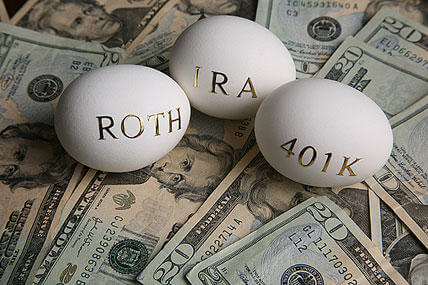With the threat of a big tax increase in January, investing in a Roth IRA now might be a good idea. Why? A Roth IRA is a source of potentially tax-free retirement income. Here are some other reasons why you might want to consider a Roth.
The Roth Rundown
Before exploring that move, it's important to understand why Roth IRAs can be appealing. "That starts with the fact that qualified withdrawals of earnings are completely free from federal income tax," says Dan McNamara, president of USAA Investments. That means every dollar in your Roth can be used for retirement needs -- unlike traditional IRAs and 401(k)s, where withdrawal of earnings essentially comes with a tax bill attached.
Roth IRAs also have a few more things going for them:
- No required minimum distributions during the account owner's lifetime. Most tax-favored retirement accounts require you to start withdrawing money -- and paying taxes -- once you reach age 70½. That's not the case with Roths during your lifetime, which means your money can be left to grow.
- Tax-planning flexibility. Having a pool of money that isn't subject to current income taxes gives you more tax-planning agility in retirement. For example, in a year where your other income is pushing you toward higher tax brackets or triggering taxes on your Social Security benefits, you can look to your Roth for money that is not currently taxed.
- A way to leave a potentially tax-free legacy. Beneficiaries of traditional retirement accounts don't just inherit your money -- they inherit a tax bill, too, because they'll owe taxes when they cash in just like you would have. With Roth IRAs, you can potentially leave an income tax-free inheritance. "With proper planning, Roth IRAs can even stretch tax-free income over multiple generations," says McNamara.
- The potential for future tax savings. Although you won't receive a current-year federal income tax deduction for making a Roth IRA contribution, you will be able to grow the contribution tax-deferred and ultimately use the contribution and any account-qualified earnings tax-free while in retirement. The value of future tax savings associated with any tax-free earnings on the contribution could exceed the value of the tax savings associated with making a pretax contribution to a traditional IRA or employer-sponsored plan. Having said that, you should usually contribute to your employer-sponsored plan at least to the extent of an employer match to ensure you "don't leave money on the table," says McNamara.
There are three ways to add a Roth to your retirement mix:
- Contribute to a Roth IRA. This is only an option if you have earned income and your modified adjusted gross income for 2012 is less than $125,000 ($183,000 for married couples filing jointly). For a married individual filing a separate return who is covered by a retirement plan at work, the phase-out range is $0 to $10,000. For 2012, you can contribute up to $5,000; if you'll be 50 or older at year's end, the limit is $6,000. For 2013, the limit increases to $5,500; if you are 50 or older at year's end, the limit is $6,500.
- Participate in a Roth employer plan. Historically, most employee contributions to work-related retirement plans were made on a pretax basis. Today, many employers provide a Roth option. Like their Roth IRA cousins, a Roth 401(k), 403(b) or Thrift Savings Plan provide no benefit of a deduction on your current tax return when you contribute but offer potentially tax-free withdrawals in retirement.
- Convert. Anyone can move money to a Roth IRA from a traditional IRA or, if your plan permits it, from a 401(k) or other employer plan. You'll pay a price for that potentially future tax-free income: Generally, you'll owe income tax on the money you move unless the money was contributed to a traditional IRA account after taxes. Unfortunately, you can't move only that money -- the IRS uses a formula that taxes the amount you move based on the proportions of pretax and after-tax money in your account.
Timing Can Be Everything
Converting generally makes the most sense when you'll be in a higher tax bracket in retirement (when you need to take withdrawals from the account) than at the time of conversion. For example, if you are subject to a current 25% tax rate, consider converting to the Roth account and taking potentially tax-free distributions when you'd otherwise have to pay tax at a 28% rate.
Unless Congress acts, nearly every American faces higher tax rates starting Jan. 1. "If that happens, converting in 2012 could be cheaper than waiting until next year," says McNamara. For example, picture a married couple with $150,000 of taxable income and a $50,000 traditional IRA funded entirely by pretax contributions. If they convert their IRA in 2012, they'd pay $14,000 for the privilege. If they convert it in 2013, the same move would cost $15,500 — almost 11% more.
It's important to consider that, even if Congress extends the current tax rates, there's still a potential for higher rates to storm back in the not-too-distant future — especially in an era of $1 trillion annual budget deficits.
The ever-present uncertainty about the tax code underscores yet another advantage of owning a Roth IRA. By having a mix of both Roth and pretax retirement money, you help avoid investing all your money in a way that bets on a single assumption about future tax rates.
Two Caveats
Before converting, consider two things:
- Your ability to pay the taxes. Generally speaking, converting only makes sense if you can pay the taxes out of other assets -- and not your IRA. That's especially true if you're under age 59½, since a withdrawal from your IRA would trigger a 10% penalty on top of ordinary income taxes.
- The impact on your tax return. Conversions raise your adjusted gross income, which affects other parts of your tax return; for example, in 2012 medical expenses are deductible to the extent they exceed 7.5% of your adjusted gross income. "Fortunately, you don't have to convert your entire balance," says McNamara. "If this is part of a long-term plan, you may want to convert gradually over the coming years." You can even undo a conversion -- in IRS lingo, that's called a "recharacterization." Generally, you have until Oct. 15 of the following year to do so. That can be an especially valuable if your investments take a dive after you convert.
"Conversion taxes are based on the value of your investments when you convert them," says McNamara. "If you convert an IRA when it's worth $50,000, and a market meltdown drags your investments down to $30,000, you may want to back out and try again at a lower value." McNamara says there's one catch: After recharacterizing a Roth conversion, IRS rules say you can't convert again until the next tax year, or 30 days -- whichever is longer.



